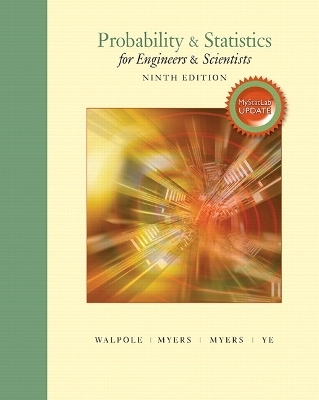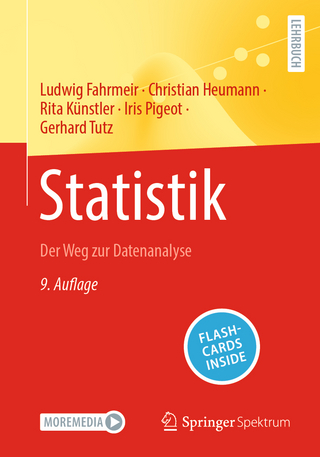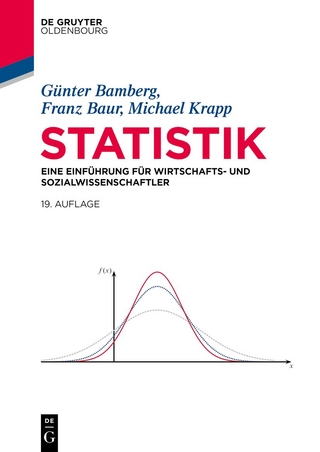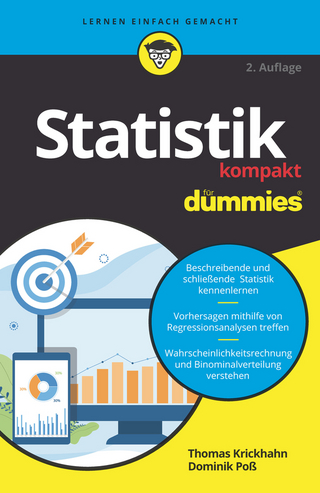
Probability & Statistics for Engineers & Scientists
Pearson (Verlag)
978-0-13-411585-6 (ISBN)
- Titel erscheint in neuer Auflage
- Artikel merken
This classic text provides a rigorous introduction to basic probability theory and statistical inference, with a unique balance between theory and methodology. Interesting, relevant applications use real data from actual studies, showing how the concepts and methods can be used to solve problems in the field. This revision focuses on improved clarity and deeper understanding.
This latest edition is also available in as an enhanced Pearson eText. This exciting new version features an embedded version of StatCrunch, allowing students to analyze data sets while reading the book.
Also available with MyStatLab
MyStatLab™ is an online homework, tutorial, and assessment program designed to work with this text to engage students and improve results. Within its structured environment, students practice what they learn, test their understanding, and pursue a personalized study plan that helps them absorb course material and understand difficult concepts.
Note: You are purchasing a standalone product; MyLab™ & Mastering™ does not come packaged with this content. Students, if interested in purchasing this title with MyLab & Mastering, ask your instructor for the correct package ISBN and Course ID. Instructors, contact your Pearson representative for more information.
If you would like to purchase both the physical text and MyLab & Mastering, search for:
0134468910 / 9780134468914 Probability & Statistics for Engineers & Scientists, MyStatLab Update with MyStatLab plus Pearson eText -- Access Card Package 9/e
Package consists of:
0134115856 / 9780134115856 Probability & Statistics for Engineers & Scientists, MyStatLab Update
0321847997 / 9780321847997 My StatLab Glue-in Access Card
032184839X / 9780321848390 MyStatLab Inside Sticker for Glue-In Packages
1. Introduction to Statistics and Data Analysis
1.1 Overview: Statistical Inference, Samples, Populations, and the Role of Probability
1.2 Sampling Procedures; Collection of Data
1.3 Measures of Location: The Sample Mean and Median
Exercises
1.4 Measures of Variability
Exercises
1.5 Discrete and Continuous Data
1.6 Statistical Modeling, Scientific Inspection, and Graphical Methods 19
1.7 General Types of Statistical Studies: Designed Experiment,
Observational Study, and Retrospective Study
Exercises
2. Probability
2.1 Sample Space
2.2 Events
Exercises
2.3 Counting Sample Points
Exercises
2.4 Probability of an Event
2.5 Additive Rules
Exercises
2.6 Conditional Probability, Independence and Product Rules
Exercises
2.7 Bayes' Rule
Exercises
Review Exercises
2.8 Potential Misconceptions and Hazards; Relationship to Material in Other Chapters
3. Random Variables and Probability Distributions
3.1 Concept of a Random Variable
3.2 Discrete Probability Distributions
3.3 Continuous Probability Distributions
Exercises
3.4 Joint Probability Distributions
Exercises
Review Exercises
3.5 Potential Misconceptions and Hazards; Relationship to Material in Other Chapters
4. Mathematical Expectation
4.1 Mean of a Random Variable
Exercises
4.2 Variance and Covariance of Random Variables
Exercises
4.3 Means and Variances of Linear Combinations of Random Variables
4.4 Chebyshev's Theorem
Exercises
Review Exercises
4.5 Potential Misconceptions and Hazards; Relationship to Material in Other Chapters
5. Some Discrete Probability Distributions
5.1 Introduction and Motivation
5.2 Binomial and Multinomial Distributions
Exercises
5.3 Hypergeometric Distribution
Exercises
5.4 Negative Binomial and Geometric Distributions
5.5 Poisson Distribution and the Poisson Process
Exercises
Review Exercises
5.6 Potential Misconceptions and Hazards; Relationship to Material in Other Chapters
6. Some Continuous Probability Distributions
6.1 Continuous Uniform Distribution
6.2 Normal Distribution
6.3 Areas under the Normal Curve
6.4 Applications of the Normal Distribution
Exercises
6.5 Normal Approximation to the Binomial
Exercises
6.6 Gamma and Exponential Distributions
6.7 Chi-Squared Distribution
6.8 Beta Distribution
6.9 Lognormal Distribution (Optional)
6.10 Weibull Distribution (Optional)
Exercises
Review Exercises
6.11 Potential Misconceptions and Hazards; Relationship to Material in Other Chapters
7. Functions of Random Variables (Optional)
7.1 Introduction
7.2 Transformations of Variables
7.3 Moments and Moment-Generating Functions
Exercises
8. Sampling Distributions and More Graphical Tools
8.1 Random Sampling and Sampling Distributions
8.2 Some Important Statistics
Exercises
8.3 Sampling Distributions
8.4 Sampling Distribution of Means and the Central Limit Theorem
Exercises
8.5 Sampling Distribution of S2
8.6 t-Distribution
8.7 F-Distribution
8.8 Quantile and Probability Plots
Exercises
Review Exercises
8.9 Potential Misconceptions and Hazards; Relationship to Material in Other Chapters
9. One- and Two-Sample Estimation Problems
9.1 Introduction
9.2 Statistical Inference
9.3 Classical Methods of Estimation
9.4 Single Sample: Estimating the Mean
9.5 Standard Error of a Point Estimate
9.6 Prediction Intervals
9.7 Tolerance Limits
Exercises
9.8 Two Samples: Estimating the Difference Between Two Means
9.9 Paired Observations
Exercises
9.10 Single Sample: Estimating a Proportion
9.11 Two Samples: Estimating the Difference between Two Proportions
Exercises
9.12 Single Sample: Estimating the Variance
9.13 Two Samples: Estimating the Ratio of Two Variances
Exercises
9.14 Maximum Likelihood Estimation (Optional)
Exercises
Review Exercises
9.15 Potential Misconceptions and Hazards; Relationship to Material in Other Chapters
10. One- and Two-Sample Tests of Hypotheses
10.1 Statistical Hypotheses: General Concepts
10.2 Testing a Statistical Hypothesis
10.3 The Use of P-Values for Decision Making in Testing Hypotheses
Exercises
10.4 Single Sample: Tests Concerning a Single Mean
10.5 Two Samples: Tests on Two Means
10.6 Choice of Sample Size for Testing Means
10.7 Graphical Methods for Comparing Means
Exercises
10.8 One Sample: Test on a Single Proportion
10.9 Two Samples: Tests on Two Proportions
Exercises
10.10 One- and Two-Sample Tests Concerning Variances
10.11 Goodness-of-Fit Test
10.12 Test for Independence (Categorical Data)
10.13 Test for Homogeneity
10.14 Two-Sample Case Study Exercises Review Exercises
10.15 Potential Misconceptions and Hazards; Relationship to Material in Other Chapters
11. Simple Linear Regression and Correlation
11.1 Introduction to Linear Regression
11.2 The Simple Linear Regression Model
11.3 Least Squares and the Fitted Model
Exercises
11.4 Properties of the Least Squares Estimators
11.5 Inferences Concerning the Regression Coefficients
11.6 Prediction
Exercises
11.7 Choice of a Regression Model
11.8 Analysis-of-Variance Approach
11.9 Test for Linearity of Regression: Data with Repeated Observations 416
Exercises
11.10 Data Plots and Transformations
11.11 Simple Linear Regression Case Study
11.12 Correlation
Exercises
Review Exercises
11.13 Potential Misconceptions and Hazards; Relationship to Material in Other Chapters
12. Multiple Linear Regression and Certain Nonlinear Regression Models
12.1 Introduction
12.2 Estimating the Coefficients
12.3 Linear Regression Model Using Matrices
Exercises
12.4 Properties of the Least Squares Estimators
12.5 Inferences in Multiple Linear Regression
Exercises
12.6 Choice of a Fitted Model through Hypothesis Testing
12.7 Special Case of Orthogonality (Optional)
Exercises
12.8 Categorical or Indicator Variables
Exercises
12.9 Sequential Methods for Model Selection
12.10 Study of Residuals and Violation of Assumptions
12.11 Cross Validation, Cp, and Other Criteria for Model Selection
Exercises
12.12 Special Nonlinear Models for Nonideal Conditions
Exercises
Review Exercises
12.13 Potential Misconceptions and Hazards; Relationship to Material in Other Chapters
13. One-Factor Experiments: General
13.1 Analysis-of-Variance Technique
13.2 The Strategy of Experimental Design
13.3 One-Way Analysis of Variance: Completely Randomized Design (One-Way ANOVA)
13.4 Tests for the Equality of Several Variances
Exercises
13.5 Multiple Comparisons
Exercises
13.6 Comparing a Set of Treatments in Blocks
13.7 Randomized Complete Block Designs
13.8 Graphical Methods and Model Checking
13.9 Data Transformations In Analysis of Variance)
Exercises
13.10 Random Effects Models
13.11 Case Study
Exercises
Review Exercises
13.12 Potential Misconceptions and Hazards; Relationship to Material in Other Chapters
14. Factorial Experiments (Two or More Factors)
14.1 Introduction
14.2 Interaction in the Two-Factor Experiment
14.3 Two-Factor Analysis of Variance
Exercises
14.4 Three-Factor Experiments
Exercises
14.5 Factorial Experiments for Random Effects and Mixed Models
Exercises
Review Exercises
14.6 Potential Misconceptions and Hazards; Relationship to Material in Other Chapters
15. 2k Factorial Experiments and Fractions
15.1 Introduction
15.2 The 2k Factorial: Calculation of Effects and Analysis of Variance
15.3 Nonreplicated 2k Factorial Experiment
Exercises
15.4 Factorial Experiments in a Regression Setting
15.5 The Orthogonal Design
Exercises
15.6 Fractional Factorial Experiments
15.7 Analysis of Fractional Factorial Experiments
Exercises
15.8 Higher Fractions and Screening Designs
15.9 Construction of Resolution III and IV Designs
15.10 Other Two-Level Resolution III Designs; The Plackett-Burman Designs
15.11 Introduction to Response Surface Methodology
15.12 Robust Parameter Design
Exercises
Review Exercises
15.13 Potential Misconceptions and Hazards; Relationship to Material in Other Chapters
16. Nonparametric Statistics
16.1 Nonparametric Tests
16.2 Signed-Rank Test
Exercises
16.3 Wilcoxon Rank-Sum Test
16.4 Kruskal-Wallis Test
Exercises
16.5 Runs Test
16.6 Tolerance Limits
16.7 Rank Correlation Coefficient
Exercises
Review Exercises
17. Statistical Quality Control
17.1 Introduction
17.2 Nature of the Control Limits
17.3 Purposes of the Control Chart
17.4 Control Charts for Variables
17.5 Control Charts for Attributes
17.6 Cusum Control Charts
Review Exercises
18. Bayesian Statistics
18.1 Bayesian Concepts
18.2 Bayesian Inferences
18.3 Bayes Estimates Using Decision Theory Framework
Exercises
Bibliography
A. Statistical Tables and Proofs B. Answers to Odd-Numbered Non-Review Exercises Index
| Erscheinungsdatum | 30.04.2016 |
|---|---|
| Sprache | englisch |
| Maße | 191 x 236 mm |
| Gewicht | 1202 g |
| Themenwelt | Mathematik / Informatik ► Mathematik ► Statistik |
| Mathematik / Informatik ► Mathematik ► Wahrscheinlichkeit / Kombinatorik | |
| ISBN-10 | 0-13-411585-6 / 0134115856 |
| ISBN-13 | 978-0-13-411585-6 / 9780134115856 |
| Zustand | Neuware |
| Haben Sie eine Frage zum Produkt? |
aus dem Bereich


